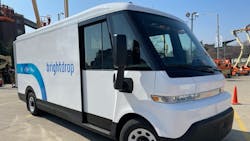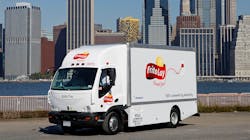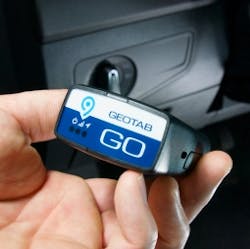Private fleets charge ahead with electrification
One of the largest private fleets in North America still is one that is showing the way for any fleet interested in the painstaking process of electrifying their freight-hauling operations.
Emily Conway, PepsiCo’s fleet sustainability manager, joined a recent webinar, “Transitioning to a Truly Sustainable Fleet,” to provide carriers some guideposts on easing EVs and the necessary charging infrastructure into their operations.
See also: Van and step van market is 100% electrifiable today, NACFE report says
The company has delved into fleet electrification since earlier in the 2000s—perhaps most prominently with its North American snack-food subsidiary, Frito-Lay—and the webinar was another entry point that FleetOwner used in recent weeks to eavesdrop on the important discussions taking place in the industry over what any fleet operator needs to know before deploying, routing, and maintaining EVs.
Some might say that goal is ambitious, but the company already operates 11 million all-electric miles with some contribution from compressed natural gas (CNG) and other sustainable vehicles, she noted. In September, PepsiCo announced a companywide sustainability transformation.
Conway said PepsiCo uses a balance of short- and long-term planning to advance its fleet sustainability goals, which also includes the use of renewable diesel that is mostly available only on the West Coast of the U.S. But EVs are clearly center stage now for PepsiCo; they are the future.
“We have been integrating aerodynamic devices for several years,” she added during the discussion. “But that’s not the way we’re going to be transforming the industry. How do we really change?”
Electrification, that’s how PepsiCo really changes, Conway said. It's been involved in that process for quite some time, at least 10 years.
“Electric and CNG require more change management and training and more capital investment,” she noted, “but they promise even greater change. Route optimization [is important] because you have to think about where charging is available. We have to be much more careful when planning these new technologies.”
For fleet managers, Conway also stressed the merits of running a mixed fleet such as PepsiCo’s, especially if you’re not sure about electrification as a long-term strategy. Mix in EVs as you phase out older diesel- or gasoline-burning vehicles; that’s what PepsiCo has done, she said. “The variety of assets is already an asset for our fleet. We’ve piloted so many different types of technologies; it’s already part of our operational profile.”
The topic of maintaining—not just buying and running them—also is coming to the fore.
Philip Saunders, who directs the City of Seattle’s Green Fleet Program and was another panelist for the webinar, stressed that any fleet—municipal, private, or for-hire—must plan for maintaining any sustainable vehicles they purchase, which requires advance planning for their maintenance shops that these vehicles are coming. “Get your mechanics in there and get them trained” in green technologies, he advised.
“Train, train, train," he added. "Give your [maintenance] people a buffer and let your people know what’s coming.”
See also: Mack offers range calculator for electric trucks
According to Joe Puff, VP of truck technology and maintenance at NationaLease, there are profound technician and shop implications to adding EVs to a fleet.
This includes having the proper safety equipment—arc flash shields, electrical safety gloves, dielectric boots and shoes, special insulated tools, etc. Procedures also have to be put in place to cover decommissioning an EV prior to beginning work on one, and technicians will need to be trained in proper EV servicing.
As recently as the week of April 11, the National Institute for Automotive Service Excellence (ASE) was hosting a three-day workshop in Leesburg, Virginia, focused on establishment of safety standards for service professionals who work on EVs. ASE is the well-known organization that certifies auto and commercial vehicle mechanics, so servicing EVs is definitely becoming top of mind for the maintenance industry if ASE has gotten involved.
Special care is even required during the upfitting of vocational and other vehicles with chassis that feature high-voltage batteries. Using the wrong drill points, for example, for a commercial body upfit can put an installer in harm's way, attendees at Work Truck Week 2022 in Indianapolis learned during a special session, "Upfitting Electric Vehicles: Work Truck Industry Challenges and Opportunities," of the Green Truck Summit.
George Bernwanger Jr., chief engineer with vocational upfitter Adrian Steel Co. and a panelist, stated the obvious during the summit special session: "Avoid the battery" and high-voltage power lines during an upfit, just like you would when accessorizing a fossil fuel-burning vehicle around its gas tank or fuel lines.
"We want to make sure everybody stays safe. We want to avoid high-voltage parts of the EV," said Ray Eyles, chief nameplate engineer on Ford Pro's 100% electric E-Transit platform and another special session panelist.
'New frontier' of asset management
Then there's that charging issue again—and how telematics offers some solutions to day-to-day operations challenges that EVs present.
Traditionally, PepsiCo's Conway said, fleet managers have needed to know where, away from HQ, their vehicles could fuel or how much diesel or gasoline they needed to order for delivery and storage at home base. Electrified fleets, however, require them to think differently—where and when to charge and build that knowledge into their duty cycles.
“Because of electrification, the new frontier of asset management is charging. Truck people have had to become experts in electric infrastructure,” Conway said, adding that PepsiCo developed an Electrification Site Prioritization (ESP) software tool, which takes into consideration fossil-fuel types—diesel, CNG, and renewable natural gas (RNG)—but looks at partnerships with electric utility companies for EVs. “We’re trying to eliminate diesel as much as we can. We balance uses at specific sites,” she said.
“Suddenly, the assets aren’t just vehicles,” added Charlotte Argue, senior manager of fleet electrification at Geotab and also a participant in the webinar. “It’s all about managing the facility and charging management.”
See also: Making the case for electric terminal tractors
Where does a telematics company like Geotab, which provides data-driven hardware and software solutions to commercial fleets, come in?
Its products empower fleets that are considering the jump to EVs to identify whether their routes are suitable for these vehicles. After adoption, Geotab’s tools also assist with route optimization and data-driven software that can pinpoint the real-time remaining range of an electric vehicle out on a run and the status of its charge—all in the name of maximizing coveted uptime and reducing dreaded downtime.
“With EVs, there are different day-to-day management issues,” Argue said, who recommended a telematics option such as Geotab’s to give fleet managers and dispatchers the ability to keep track of data that is unique to electrified operations.
“This is where real-time status of charge can be pulled into dispatching operations. Dispatchers can have confidence that those vehicles are actually being plugged in. That’s quite a bit different than a [gas- or diesel-powered fleet]. It’s an inconvenience to have to go someplace to fuel up, but an uncharged vehicle means several hours of downtime.”
“Good data is essentially fundamental to make good decisions in your sustainable strategy. For any new technology, you want to be able to do an assessment and figure out your ‘use case.’ You’re going to be a lot more accurate in this if you base [your decision] in real data,” she said.
Argue recommended comparing the fuel economy of the fossil-fuel burning vehicles in your fleet with the cost of electricity for your prospective EVs. Also ask, she advised, whether seasonal changes are relevant to your operations; for example, will your EVs operate in very cold or very hot conditions? Geotab uses its EV Suitability Assessment Tool (EVSA) to even determine this.
“Sometimes, the data proves your assessment inaccurate. EVs are proving more useful and TCO-friendly. Telematics can benchmark your fleet to other similar fleets. [It can] improve routing, your driver fuel-management habits, and balance that with evaluating new types of fuel.”
In a separate interview with FleetOwner, Rob Minton, Geotab’s associate VP for connected cars, weighed in on how data from any vendor can help commercial fleets make that go/no-go decision about electric vehicles.
“If you’re operating a fleet and you’re interested in adding EVs, the No. 1 issue is that the EV has to be able to do the job that [internal combustion engine, or ICE] vehicles do,” Minton said. “That requires good analysis.”
Just as Argue did, Minton mentioned Geotab’s EV Suitability Assessment Tool. “Look at real-world data with EVSA. How many miles a day, what’s being driven, what’s the geography, [what’s the] payload? We look at that data and run it through the assessment tool."
“You could replace 10 of those [ICE] vehicles tomorrow and lose no capability," Minton continued. "We would actually show you what EVs you could replace those ICE vehicles with.”
Geotab makes its EVSA available to all its fleet customers at no charge through the MyGeotab portal on its website. “With one click of [the EVSA button], it’s going to start running that analysis,” he said.
OEMs feature Geotab solutions aboard their electric vehicles, Minton said. Count among them Electric Last Mile Solutions (ELMS), a maker of Class 1 electric urban delivery vans with a range of about 110 miles. Geotab’s GO tracking device is embedded aboard ELMS vans. “That’s a big plus from an end-user standpoint. That gives a company like Electric Last Mile Solutions a competitive advantage.”
Geotab brings its long experience with ICE fleets to the table with EVs—diagnostic information, location information, route optimization, real-time state of charge. “I don’t want to send an EV out to a customer if it doesn’t have enough charge,” Minton said.
Most fleets, he said, are going to charge their EVs at a central depot. Geotab solutions can even tell a fleet which of their vehicles are charging and not in use and how long it will take for them to reach full charge. Minton added: “Depending on that infrastructure provider, we can even tell a driver which charging stations are available. Time is money. To be able to tell a fleet that they can pull right up and charge that vehicle is hugely important.”
Editor's note: This is the second part of our look into the many aspects of EV adoption and the questions fleet operators should ask before making the leap to electrification. Part 1 appeared April 12—and please look for the third and final part of the series later this week. These stories ran in abbreviated form as one piece in the April edition of FleetOwner magazine.
About the Author
Scott Achelpohl
Managing Editor
Scott Achelpohl is a former FleetOwner managing editor who wrote for the publication from 2021 to 2023. Since 2023, he has served as managing editor of Endeavor Business Media's Smart Industry, a FleetOwner affiliate.




